D0486 | axitinib
L
L01XE17 Axitinib
[L01XE] Protein kinase inhibitors
[L01X] OTHER ANTINEOPLASTIC AGENTS
[L01] ANTINEOPLASTIC AGENTS
[L] Antineoplastic and immunomodulating agents
| Toxicity | Dose | Time | Species | Model | Method | Action | Positive criterion | Reference |
|---|---|---|---|---|---|---|---|---|
| MEMBRANE POTENTIAL | 3.76±2.80 | human | qHTS-HepG2 | MMP assay | decrease | IC50 | 163 | |
| MEMBRANE POTENTIAL | 1.09 | human | HepG2 | MMP assay | decrease | IC50 | 163 | |
| MEMBRANE POTENTIAL | rat | hepatocytes | MMP assay | Negative | IC50 | 163 | ||
| ELECTRON TRANSPORT CHAIN | rat | isolated liver mitochondria | measurements of mitochondrial respiration; RST inhibition assay, RST uncoupling assay; IC 50ratio of glucose/galactose assay | decrease | 53 | |||
| Pictogram | Signal | Statements | Precautionary Statement Codes |
|---|---|---|---|
   |
Warning |
Aggregated GHS information provided by 68 companies from 3 notifications to the ECHA C&L Inventory. Each notification may be associated with multiple companies. H302 (55.88%): Harmful if swallowed [Warning Acute toxicity, oral] H341 (42.65%): Suspected of causing genetic defects [Warning Germ cell mutagenicity] H361 (44.12%): Suspected of damaging fertility or the unborn child [Warning Reproductive toxicity] H373 (44.12%): Causes damage to organs through prolonged or repeated exposure [Warning Specific target organ toxicity, repeated exposure] H400 (57.35%): Very toxic to aquatic life [Warning Hazardous to the aquatic environment, acute hazard] Information may vary between notifications depending on impurities, additives, and other factors. The percentage value in parenthesis indicates the notified classification ratio from companies that provide hazard codes. Only hazard codes with percentage values above 10% are shown. |
P201, P202, P260, P264, P270, P273, P281, P301+P312, P308+P313, P314, P330, P391, P405, and P501; (The corresponding statement to each P-code can be found at the GHS Classification page.) |
| (E)-N-Methyl-2-((3-(2-(pyridin-2-yl)vinyl)-1H-indazol-6-yl)thio)benzamide | (E)-N-methyl-2-(3-(2-(pyridin-2-yl)vinyl)-1H-indazol-6-ylthio)benzamide | 319460-85-0 |
| 460A850 | 4CA-0215 | 4ag8 |
| 4agc | A10103 | AB0008632 |
| AB01274739-01 | AB01274739_02 | ABP000115 |
| AC-1539 | AG 013736 | AG-013736 |
| AG-013736;Axitinib | AG-13736 | AG013736 |
| AG13736 | AKOS015902898 | AM20090673 |
| AOB87786 | Axitinib | Axitinib (AG 013736) |
| Axitinib (JAN/USAN) | Axitinib [USAN:INN:JAN] | Axitinib, >=98% (HPLC) |
| Axitinib,AG-013736 | Axitinib/AG013736 | BCP01371 |
| BCP9000345 | BCPP000372 | BDBM25117 |
| BRD-K29905972-001-01-4 | BRD-K29905972-001-02-2 | Benzamide, N-methyl-2-((3-((1E)-2-(2-pyridinyl)ethenyl)-1H-indazo)-6-yl)thio)- |
| Benzamide, N-methyl-2-[[3-[(1E)-2-(2-pyridinyl)ethenyl]-1H-indazol-6-yl]thio]- | C22H18N4OS | C9LVQ0YUXG |
| CAS-319460-85-0 | CHEBI:66910 | CHEBI:94568 |
| CHEMBL1289926 | CS-0116 | D03218 |
| DB06626 | DSSTox_CID_28975 | DSSTox_GSID_49049 |
| DSSTox_RID_83240 | DTXSID3049049 | EX-A337 |
| GTPL5659 | HY-10065 | Inlyta |
| Inlyta (TN) | J-502064 | KS-1448 |
| MFCD09837898 | MLS006010164 | N-METHYL-2-(3-((E)-2-PYRIDIN-2-YL-VINYL)-1H-INDAZOL-6-YLSULFANYL)-BENZAMIDE; |
| N-Methyl-[[3[(1E)-2-(2-pyridinyl)ethenyl]-1H-indazol-6-yl]thio]-benzamide | N-methyl-2-((3-((1E)-2-(pyridin-2-yl)ethenyl)-1H-indazol-6-yl)sulfanyl)benzamide | N-methyl-2-({3-[(E)-2-(pyridin-2-yl)ethenyl]-1H-indazol-6-yl}sulfanyl)benzamide |
| N-methyl-2-({3-[(E)-2-(pyridin-2-yl)vinyl]-1H-indazol-6-yl}sulfanyl)benzamide | N-methyl-2-({3-[(E)-2-pyridin-2-ylethenyl]-2H-indazol-6-yl}sulfanyl)benzamide | N-methyl-2-[[3-[(E)-2-pyridin-2-ylethenyl]-1H-indazol-6-yl]sulfanyl]benzamide |
| NCGC00241108-01 | NCGC00241108-04 | NCGC00241108-06 |
| NSC-757441 | NSC757441 | Q-200662 |
| Q-3279 | Q4830631 | QCR-109 |
| S1005 | SB20061 | SC-22491 |
| SCHEMBL172918 | SMR002530046 | SR-01000941566 |
| SR-01000941566-1 | SW219464-1 | SYN1014 |
| TR-013491 | Tox21_113597 | Tox21_113597_1 |
| UNII-C9LVQ0YUXG | ZINC3816287 | axitinibum |
| cc-356 |

